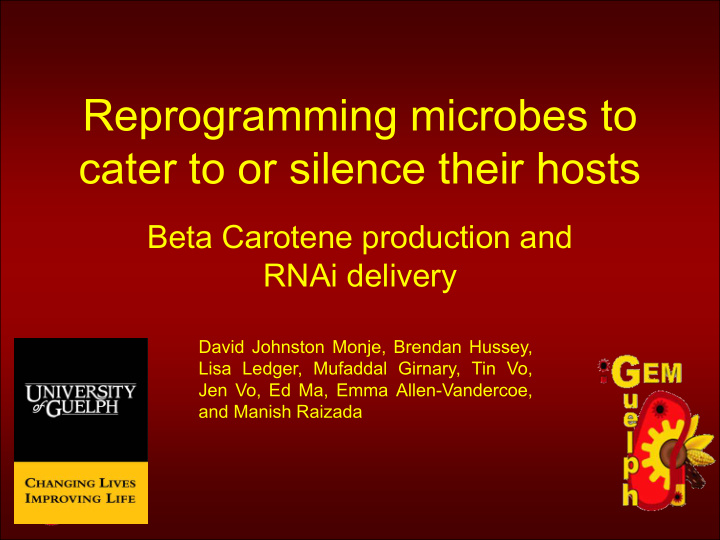



Reprogramming microbes to cater to or silence their hosts Beta Carotene production and RNAi delivery David Johnston Monje, Brendan Hussey, Lisa Ledger, Mufaddal Girnary, Tin Vo, Jen Vo, Ed Ma, Emma Allen-Vandercoe, and Manish Raizada
The University of Guelph • Established in 1969, but various colleges such as the Ontario Agricultural College and the Ontario Veterinary College date back to the 19 th Century. • U of G has a strong focus on agriculture, but is also known for innovation generally. • U of G is also known for having the best cafeteria food among Canadian universities.
The University of Guelph Johnston Hall in the fall, one of U of G’s most recognizable sights. (Also, team member Lisa’s freshman residence.)
U of G’s First iGEM Team
Where there’s a Problem, Synbio Might Help • Food • Materials • Medicine •Collaboration with Calgary Ethics •Sharing with Minnesota Time Bomb and Edinburgh
Bacterial Software on Plasmid Floppy Disks: • Food • Materials • Medicine
A Bacterially Expressed Host Plant RNAi Program • Bacterially Induced Gene Silencing (BIGS) is a technique we hope to develop as an enabling technology for plant functional genomics • Potentially better than mutants, transgenic plants, and VIGS • Will deliver RNAi to a plant via the use of endophytic or symbiotic bacteria transformed with a RNAi construct transcribing plasmid Applied and Environmental Microbiology, February 2000, p. 783-787, Vol. 66, No. 2
Why Would BIGS Work? • Bacteria lyse upon cell death, releasing their contents into the surrounding environment (MICROBIOLOGY AND MOLECULAR BIOLOGY REVIEWS,Sept. 2000, p. 503–514) • Plants have systemic responses – the presence of RNAi in one region of the plant can induce signalling across the plant ( Nature 431 , 356-363 [16 September 2004] ) • Plants are very sensitive to dsRNA – spraying lysed E. coli on plants protects them against virus (BMC Biotechnol. 2003; 3: 3) • Transkingdom RNAi in mice already proven possible (Nature biotechnology, 2006, 24:6, pp. 697-702)
BIGS Results:
Bacteria Induced Gene Silencing
BIGS Results: Black and white corn and tb1 mutant image reproduced from Nature Reviews Genetics 3, 11-21 (January 2002)
A Vitamin Synthesis Programme - Beta Carotene Production from a Synthetic Operon crtB crtE crtI crtY Map and chemical structure obtained via WikiCommons
Why Should SynBiologists Care? • Vitamin A deficiency causes 250,000 to 500,000 cases of blindness in children each year worldwide (WHO, 2008) • Vitamin A increases resistance to measles (Chan, 1990), and in increases birth weights while decreasing antenatal complications of babies born to HIV positive mothers (Kumwenda et al , 2002).
Can Synbio Help? • Golden Rice and Golden Rice II were engineered to offer a dietary source of beta carotene to deficient populations where rice is a staple food – this has yet to be realized. • We believe that golden bacteria might fit a special niche – Might Calgary Ethics agree?
What?
How did we build it? • The PCR primers for all of our genes of interest, as well as the promoter, were designed to add Spe I, Xba I and Pst I restriction sites. • The Spe I and Xba I generate complementary sticky ends. • Iterative ligation steps involving cutting the vector with Spe I and the insert with Xba I result in the fusion of the restriction sites, with Pst I left intact for future use.
How did we build it? •Insertion of crt-E from Erwinia uredevora •Insertion of crt-B from Erwinia uedevora •Insertion of crt-I from Erwinia uredevora •Insertion of crt-Y from Erwinia uredevora •Insertion of GFP gene from BioBrick BBa_E0240 •Insertion of arabinose inducible or 250 bp promoter from pDSK-GFPuv
Testing parts - results
Results:
Results: •The plasmid with the beta carotene ‘program’ was transferred to pDSK-GFPuv and electroporated into E. coli Nissle and Kp342, but we did not get a chance to test this in the intestinal model. •Intestinal model was set up testing survival and plasmid maintenance of Nissle containing unmodified pDSK- GFPuv and DH5 α containing Ara or PSBA promoters driving Bba_K118005 in pSB1A2.
Where Do We Go Next? • BIGS – Wait for corn to grow for evaluating phenotype – Publish and promote BIGS to scientists working on corn functional genomics • Beta carotene production – Test the beta-carotene cassette in pDSK-GFPuv in lab strains first, then in Nissle, Kp342 – Switch to pTG262 and test in lactobacilli – Establish partnerships with institutes working in biofortification and international development
Thanks to Our Contributers • Dr. Manish Raizada, for guidance and use of his lab space and supplies. • Dr. Emma Allen-Vandercoe, for guidance, lab supplies, and bacterial strains. • The Universities of Minnesota and Edinburgh, for Erwinia urevedora genes. • The University of Calgary’s Ethics Team, for collaboration.
Thanks To Our Sponsors:
How would we test BIGS? • Define TB1 mutation phenotype – show picture • The modification of a Zea mays intron construct to contain the BioBrick BBa_B1006’s strong transcription termination signal. • Ligation of the modified intron into a plasmid vector • The transformation of electroporated Klebsiella pneumonii, a corn endophyte, with the plasmid vector. • Innoculation of corn seedlings with Klebsiella pneumonii.
Recommend
More recommend